
Do you need rehabilitation services to help you with an injury or disability but don’t know what type of care would best suit your needs? Occupational therapy (OT) and physical therapy (PT) are two services offered by our team at Access Sports Medicine. What is the difference between occupational therapy and physical therapy? Let’s walk you through it!
The main difference between occupational therapy and physical therapy lies in the focus of their treatments. Physical therapists (PTs) focus on helping patients become healthier and improve their movement through exercises and using specialized equipment. On the other hand, occupational therapists (OTs) aim to restore a patient’s ability to complete tasks or activities that enable them to get back to their respective sport or activity as soon as possible.
What is the Definition of Physical Therapy?
Physical therapy is a type of health care that focuses on preventing or improving impairments caused by injury or illness. Physical therapists use exercises, manual therapy techniques, special equipment, and education to help reduce pain and restore movement so patients can reach their maximum potential for mobility and function. Therapists use the latest evidence-based practices to help improve balance, strength, endurance, coordination, and posture in order to help rehabilitation patients regain their independence.
Common practices:
- Gait training and balance exercises
- Strengthening exercises
- Range of motion exercises
- Pain management techniques
- Hot or cold therapy
- Posture correction exercises
- Joint mobilization and manipulation techniques
- Ultrasound, electrical stimulation, and other forms of modalities
- Neuromuscular reeducation and coordination training
- Orthotics fitting and usage instruction
- Ergonomic evaluation and recommendations for work and applicable activities
What is the Definition of Occupational Therapy?
Occupational therapy is a specialized form of assistance that caters to individuals of all ages who have limited abilities due to physical, medical, or developmental conditions. From carpal tunnel syndrome to brain injuries, occupational therapists provide a range of services aimed at improving patients’ ability to perform daily tasks. By modifying the patient’s environment, situation, and skillset, occupational therapists can help them attain their goals successfully. The responsibilities of an occupational therapist include observing patients as they perform certain tasks, reviewing their full medical history, evaluating their specific needs and condition, creating tailored treatment plans based on individual goals, demonstrating exercises that alleviate pain for chronic conditions, and assessing the patient’s workplace or home to identify ways it can be better adapted to meet their needs. Occupational therapy sessions are always one-on-one with the patient in order to ensure personalized care. Additionally, our department performs ergonomic job site evaluations and is skilled in splint fabrication.
Common practices:
- Carefully observing patients as they perform specific tasks
- Assessing the patient’s condition and individual needs
- Developing a personalized treatment plan centered around the patient’s goals
- Teaching exercises that alleviate pain associated with chronic conditions
- Evaluating the patient’s workplace or home to identify areas where it can be better adapted to meet their needs
Both PTs and OTs provide interactive sessions that can be tailored according to a patient’s individual needs.
Occupational Hand Therapy
A major component of the occupational therapy program here at Access is related to the care of the hands. This makes sense, given our hands are essential tools we use daily, and it’s only when they’re hurt and not working properly that we understand how important they are. Injury or other conditions affecting the hands can majorly impact our lives. Occupational therapy can help us to manage such conditions, thus preserving roles, habits, and overall psychological well-being. Here are some of the main benefits of occupational therapy when it comes to hand therapy:
- Personalized and tailored treatment plans that focus on everyday functions
- Increased motivation as patients see the real life application of their treatments
- More cost effective rehabilitation with everyday items instead of expensive equipment
- Treatment sessions held in familiar settings outside the clinical environment
- Homework exercises intrinsic to everyday routines
If you’re dealing with an injury or condition affecting your hands, don’t hesitate to contact us and meet with an experienced occupational therapist specializing in hand therapy. Caring for our hands under professional supervision can ensure we don’t worsen any problems through unhelpful habits, so your hands can become all they were meant to be!
Moving Forward with Proper Therapy
At Access Sports Medicine, our skilled team of therapists offers personalized plans and treatments designed to address each patient’s specific needs. We understand that no two injuries are the same, so we customize our approach to ensure the best possible outcome for every person in our care. Our goal is to get you back doing what you love most: participating in sports, enjoying life with your friends and family, or taking on new challenges!
We provide comprehensive assessments to identify what type of therapy (OT or PT) would be most beneficial for your recovery. If you’re unsure what type of treatment is right for you, or if you have any questions about what our team can do to help you, don’t hesitate to contact us today. We’re here to provide the best possible care and support to get you back on track and living a healthy life!


